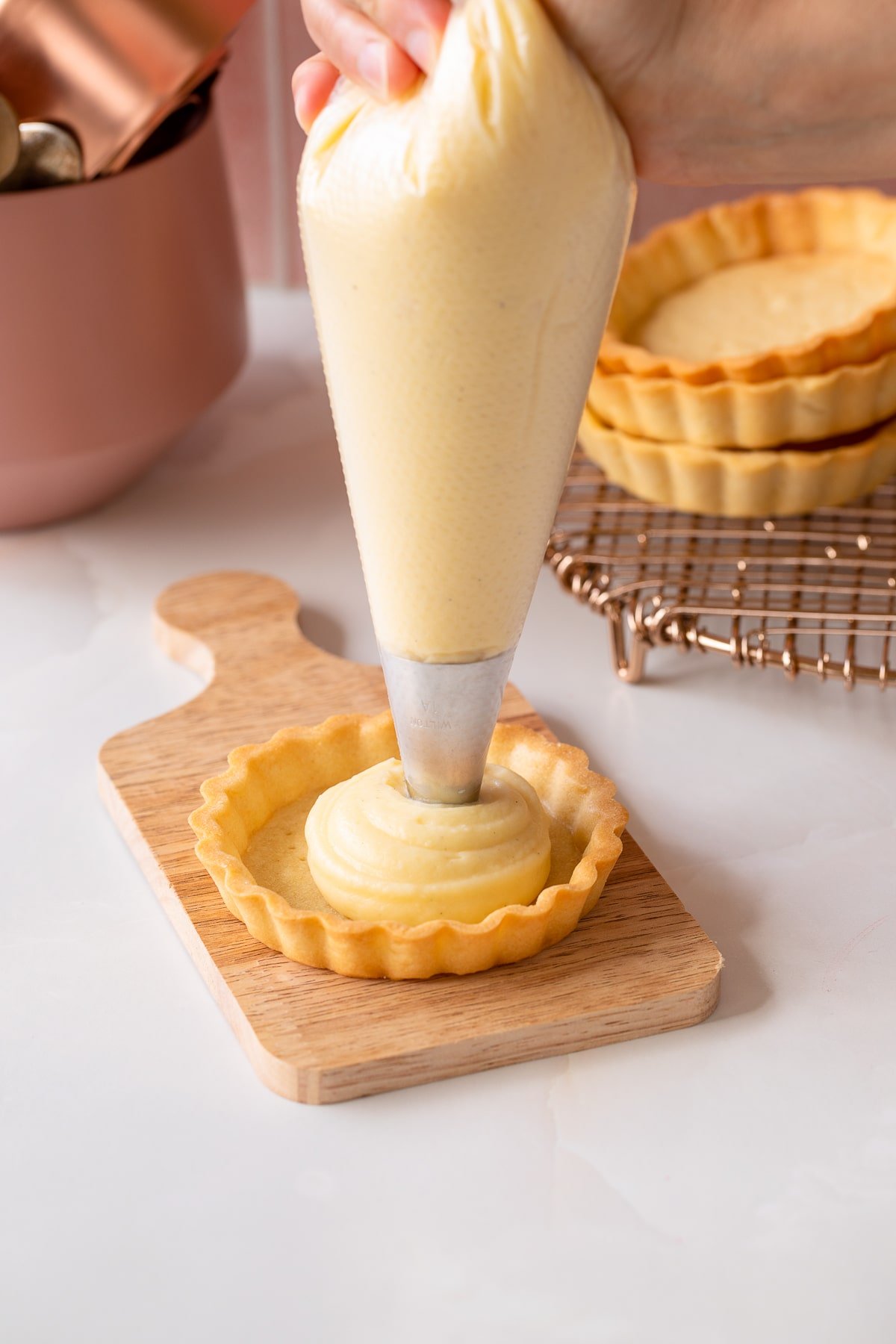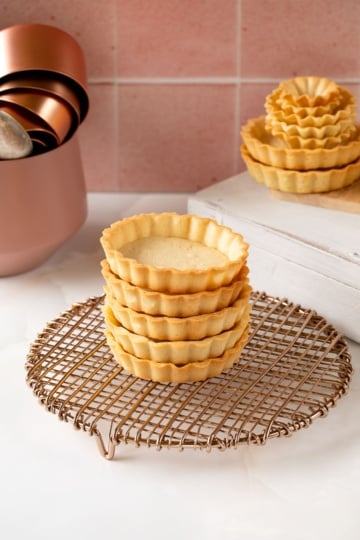This vanilla pastry cream recipe (also known as Creme Patissiere) is a perfect filling for cream puffs, tarts, pastries, cakes, and other delicious desserts! With step-by-step instructions and troubleshooting tips you’ll be able to make this simple dessert filling.
Pastry cream or Creme Patissiere is such a simple and delicious dessert filling. Using both egg yolks and cornstarch as a thickener, it's a tasty mix between a pudding and a custard.
It's most commonly used as a filling for tarts, cream puffs, cakes, and trifles.
Ingredients
- Milk: For this recipe, whole milk is the most common but you can substitute half the milk for whipping cream for a creamier more decadent vanilla pastry cream.
- Egg Yolks: While not necessary, free range pasture raised egg yolks make a big difference in the final flavor.
- Vanilla: Real vanilla bean or vanilla bean paste really takes vanilla Creme Patissiere to the next level!
How to Make
Step 1: Heat Milk
In a saucepan bring milk, vanilla, and salt to a simmer over medium heat.
Step 2: Mix and Temper Egg Yolks
In a separate bowl, whisk together the egg yolks, sugar, cornstarch. It should be thick, creamy, and pale yellow.
While whisking, slowly add ½ cup of the hot milk mixture to the egg yolk mixture to temper it. This insures that the eggs don't overcook and curdle.
Add the remaining milk mixture half a cup at a time, while continuously mixing.
Step 3: Cook
Return to saucepan and cook over medium to medium low heat a few minutes, until the mixture is thick and bubbling. Once the mixture starts boiling remove from heat.
If adding butter, add one tablespoon at a time and mix until fully incorporated before adding the next.
Sometimes the butter separates a bit and makes the mixture greasy. If this happens, whisk continuously for a few minutes until it's fully combined and cooled down a bit. It should recombine and no longer be greasy.
Step 4: Strain and Chill
Once everything if fully combined and slightly cooled, pour the mixture through a strainer into another bowl. This will make for a very smooth Creme Patissiere and ensure there is no cooked egg or lumps in the mixture.
Then, cover with plastic wrap, placing the wrap directly on top of the cream so it doesn't get a film on top. Then chill until ready to use, at least two hours or overnight.
Troubleshooting
Why is my pastry cream so lumpy?
It's really common to have some lumps in the pastry cream from cooking and thickening. Here are a few tricks to help prevent too many lumps from forming:
- Don't cook on too high of heat
- Stir or whisk the mixture constantly while cooking
- Remove from heat right after it starts to boil
To get rid of the lumps, strain the mixture over a fine mesh strainer (strain twice if it's particularly lumpy).
You can also cook the milk mixture over a double broiler if lumpy or overcooked pastry cream is an issue.
Why is my pastry cream so thick?
Pastry cream filling is actually very versatile and can be made thicker or thinner depending on certain variables. If you want a thinner consistency cream, use 2.5 tablespoons of cornstarch rather than 3.
If you find it's too thick immediately after making it, you can mix in 1-2 tablespoon of milk at a time while the mix is still warm, until you get the desired consistency.
And know, in bakeries pastry cream is often made a bit thicker which is perfect for piping, or filling tarts and cakes. Since it’s thicker it’s sturdier for holding fruit or cake layers.
For a lighter and airier pastry cream filling, stabilized whipped cream is added to create a creme diplomat or Italian meringue is added to create a creme aglaise, which is often used to fill cream puffs and eclairs.
Why does my Creme Patissiere look separated and greasy after adding the butter?
Sometimes the butter separates a bit and makes the mixture greasy. If this happens, whisk continuously for a few minutes until it's fully combined and cooled down a bit. It should recombine and no longer be greasy.
Why is my cream so stiff and gel like after chilling?
This is totally normal! After chilling the creme patissiere, especially if you chill it overnight or for a few days, it will be pretty firm right after removing it from the fridge.
Just let it soften up at room temperature for few minutes and then stir or whisk it again and it will really soften up into a perfectly pipeable consistency.
Why is my pastry cream gray?
This can be a chemical reaction from using aluminum pans. Be sure to use stainless steel pan or other non-aluminum pan.
What should I do with the leftover egg whites?
We've got your covered! Meringue based desserts are so fun to make. Meringue Cookies are great, and I highly recommend trying French Macarons which calls for almost exactly 5 egg whites.
You can also make Italian Meringue or Swiss Meringue Buttercream or Marshmallow Frosting as well!
Tips and Tricks for Perfect Pastry Cream, Every Time!
- While not necessary, free range pasture raised egg yolks make a big difference in the final flavor of the Creme Patisserie and give it a lovely deep yellow color!
- Heat the milk until just simmering. If it's too hot it can scorch the milk and overcook the egg yolks.
- Once you return the milk and egg mixture back to the stovetop, be sure to cook very slowly over low to medium heat. If you cook too fast or over too high of heat it can cause the mixture to curdle or get lumpy.
- If the mixture does gets lumpy – no problem! Just be sure to strain out the lumps one or two times.
Storing Pastry Cream
This recipe will last 3-5 days in the fridge in an airtight container.
Unfortunately, you can not freeze pastry cream as you will loose the creamy pudding like texture when it defrosts (trust me-I’ve tried freezing it thinking how bad can it be, and it’s bad! It turns to a weird spongy consistency that is not remotely spreadable or pipe-able).
WANT TO JOIN THE PARTY? Subscribe to my newsletter and follow on Pinterest, Instagram, and Facebook for all the latest recipes!

Pastry Cream
Equipment
- Saucepan
- Whisk
INGREDIENTS
- 2 cups whole milk
- 1 tsp vanilla extract or vanilla bean paste
- pinch of salt
- 5 large egg yolks
- 3 tbsp cornstarch 2 1/2 tbsp for a looser consistency filling
- ½ cup granulated sugar
- 2 tbsp unsalted or salted butter optional
Instructions
- In a saucepan bring milk, vanilla, and salt to a simmer over medium heat. Do not boil the milk as it can overflow the pan and also overcook the eggs when tempering.
- In a separate bowl, whisk together the egg yolks, sugar, cornstarch. It should be thick, creamy, and pale yellow.
- While whisking, slowly add ½ cup of the hot milk mixture to the egg yolk mixture to temper it. This insures that the eggs don’t overcook and curdle.
- Add the remaining milk mixture half a cup at a time, while continuously mixing.
- Return to saucepan and cook over medium low to medium heat until the mixture is thick and bubbling. Remove from heat once the mixture boils.
- If adding butter, add one tablespoon at a time and mix until fully incorporated before adding the next. Sometimes the butter separates a bit and makes the mixture greasy. If this happens, whisk continuously for a few minutes until it’s fully combined and cooled down a bit. It should recombine and no longer be greasy.
- Once everything is fully combined and slightly cooled but still warm, pour the mixture through a fine mesh strainer into another bowl. This will make for a very smooth pastry cream.
- Cover with plastic wrap, placing the wrap directly on top of the pastry cream filing so it doesn’t get a film on top.
- Then chill until ready to use, at least two hours or overnight.
Notes
- While not necessary, free range pasture raised egg yolks make a big difference in the final flavor and gives it a lovely deep yellow color!
- Heat the milk until just simmering. If it’s too hot it can scorch the milk and overcook the egg yolks.
- Once you return the milk and egg mixture back to the stovetop, be sure to cook very slowly over low heat. If you cook too fast or over too high of heat it can cause the mixture to curdle or get lumpy.
- If the mixture does get lumpy or curdle - no problem! Just be sure to strain out the lumps one or two times.
- This recipe last 3-5 days in the fridge in an airtight container.















Leah says
I don’t think I cooked it enough before refrigerating because it’s not setting. Can I return to stove top to cook more ?
Leah says
I may not have cooked my cream enough before putting in refrigerator so it’s not “set.”
Can I return to stove top to thicken a bit more?
Ruth Grindeland says
I made your cream pat and it turned out wonderful. Thank you for the detailed pictures. It made the steps easy to understand.
Amanda Wren-Grimwood says
I’ve been wanting to make some fruit tarts and this recipe has come at the perfect time – thanks!
Ieva says
A lovely recipe that I think every home cook should be able to master! We love your recipe and pastry cream turns our silky smooth every time. Perfect for French Fruit Tart!
Anjali says
My pastry cream turned out perfectly thanks to your helpful guide!! I had never made pastry cream from scratch before and with your tips it was actually pretty easy to do!
Janessa says
I’ve never tried making pastry cream before because it always seemed so intimidating. This post is very thorough, though, so I think I may be confident enough to give it a try!
Emily says
This pastry cream turned out perfect thanks to your instructions! I filled tart shells and topped them with fresh fruit. So elegant and tasty!